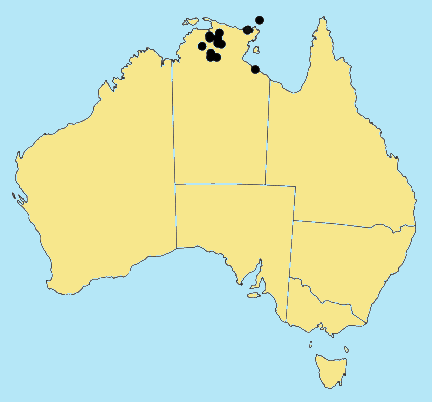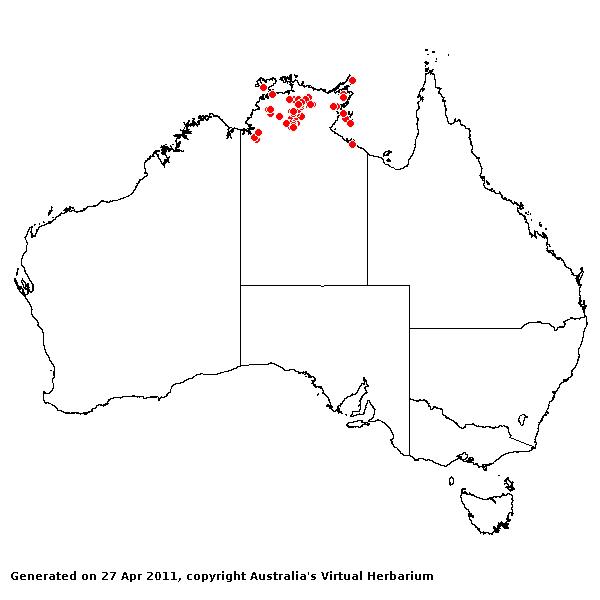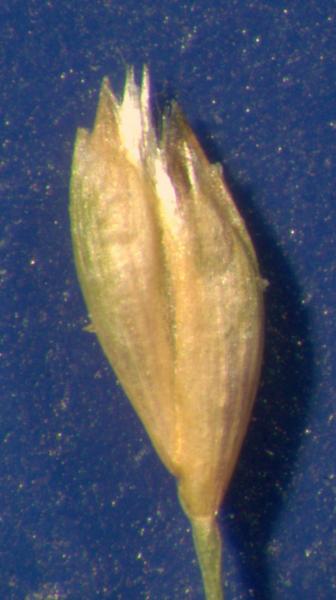Eriachne capillaris R. Br. Prodr. 184
(1810).
Classification. (GPWG 2001) : Subfamily Micrairoideae.
Eriachneae.
Type of Basionym or
Protologue Information: HT: R. Brown 6265, 1803, Australia: Northern
Territory: Darwin and Gulf District: North Coast, Arnhem Bay (Bay 3) (BM; IT:
B, BR, C, CANB, E, G, K, US-734049).
Key references
(books and floras): [1810]. R.Brown, Prodromus (184), [1878]
G.Bentham, Flora Australiensis 7 (632), [2002] D.Sharp & B.K.Simon, AusGrass,
Grasses of Australia.
Illustrations:
[2005] K.Mallet (ed.), Flora of Australia 44B: Poaceae 3 (Fig.
27A-B).
Habit. Annual
or ephemeral. Culms erect or geniculately ascending, 12.5–50 cm tall. Mid-culm
nodes pubescent. Lateral branches branched or fastigiate. Leaf-sheaths hairy.
Ligule a fringe of hairs. Leaf-blades 1–2 cm long, 0.5–1 mm wide. Leaf-blade
surface indumented.
Inflorescence.
Inflorescence compound, a panicle. Panicle ovate, effuse, 6–10 cm long, 2–9 cm
wide.
Spikelets.
Spikelets pedicelled. Fertile spikelets 2-flowered, both fertile, comprising 2
fertile floret(s), without rachilla extension, ovate, laterally compressed, 1–2
mm long.
Glumes.
Glumes similar, thinner than fertile lemma. Lower glume ovate, membranous,
without keels, 5–7 -nerved. Lower glume surface glabrous. Upper glume ovate,
1–2 mm long, membranous, without keels, 5–7 -nerved. Upper glume surface
smooth, glabrous.
Florets.
Fertile lemma 1–2 mm long, without keel, 3–5 -nerved. Lemma surface indumented. Lemma apex muticous.
Palea apex entire, muticous. Grain 1 mm long.
Continental
Distribution: Australasia.
Australian
Distribution: Northern Territory.
Northern Territory:
Darwin & Gulf.
Notes.
The species is recognised by a combination of characters, slender short-lived
habit, hispid basal foliage, open capillary panicle, obovate spikelets,
fusiform awnless curved florets that are slightly longer than glumes, and acute
callus which is longer than many. Characteristically, the glumes appear uneqal
due to their oblique (not opposite) attachment, and this condition applies also
to the pair of florets. In indumentum, the lemma is partly glabrous and its
palea entirely pubescent, unlike the common condition in many species in which
the lemma and palea are similar. E. capillaris has similarities with E.
filiformis and E. agrostidea, but differs from both species by its
smaller spikelets and awnless florets.
Endemic.
N.T. N of 15ºS on mainland and islands. Predominantly in shallow sands on
outcrops, plateaux, mesas and hillslopes of sandstone; recorded also on
laterite gravel, gritty and stony sand, seepage, crevices, depressions and
small valleys. Flowers and fruits Feb.-July (late-summer to mid-winter).




